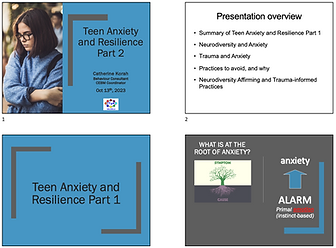Theoretical Framework
ADOLESCENCE
Adolescence literally means ‘growing into maturity’. An adolescent is neither child nor adult and therein lies much of the challenge. Our role as adults is to help our teens embrace their developmental destiny; However, we are faced with the day-to-day duty of teaching, guiding and directing them. The aim of this presentation is to make sense of the adolescent from inside out. Although each teen is an individual, there are some common dynamics that affect all adolescents. Understanding what these dynamics are can provide the keys for knowing how to deal with the problems that may arise.
Editorials
17 Brain Breaks Tailored for High Schoolers
Paige Tutt - Edutopia
Kids, like adults, cycle through periods of attention and inattention—though the duration of the interval changes with age, and is variable across individuals. By high school, according to neurologist and classroom teacher Judy Willis, concentrated study of “20 to 30 minutes for middle and high school students calls for a three- to five-minute break.”
The importance of making space for teens’ thoughts, feelings, and ideas
Hannah Beach
Adolescence is typically the first time kids dive into their internal world, it’s normal to wonder if they are the ‘only one.’ Teachers play a crucial role in providing an important space for ‘percolation and expression’. When youth are given the time and space to explore the richness of their inner world, it can lower their alarm, decrease frustration and support them on their journey into adulthood.
Making Sense of Adolescents
Deborah MacNamara
Mark Twain wrote, “When I was a boy of 14, my father was so ignorant I could hardly stand to have the old man around. But when I got to be 21, I was astonished at how much he had learned in seven years.” Twain captured the arrogance, self-absorption, and idealism of the teenage years so well.
Why Your Teen Reminds You of a Preschooler
Deborah MacNamara
Sometimes parents lament to me in a humour filled way, that they see similarities between raising teens and toddler/preschoolers. What is it that makes them feel similar? What do they need from us as we steer them through these developmental periods? There are three key developmental dynamics that are inherent to both tots and teens, despite their differences in maturity levels and performance.
The Challenge of Holding On to Our Young Teens
Robin Brooks-Sherriff
Anyone spending time with a young teenager knows that they can be lovely and intriguing one moment and irrational and angry the next. Their emotions are strong and their prefrontal cortex is under major reconstruction, resulting in incredible highs, desperate lows, mature insight, and impulsive reactions – sometimes all in one day.
HELP! Adolescent Angst Then and Now
Tamara Strijack
I sit here listening to the lyrics of a song my daughter wrote when she was 15, and it brings me right back:
I’m floating away, seems my mind just won’t stay in my brain. It’s all just a haze and the ghosts overtake me, no escape … no escape. I’m going in circles … what happened to “everything’s okay?” I’m stumbling through it all. I’ll get there some day.
Circles … stumbling … no escape.
The Counterwill Storm: Making Sense of Adolescent Resistance
Darlene Denis-Friske
Anytime I am working with the parents of adolescents, I am always excited to share insight about the pivotal concept of “counterwill” in the context of healthy development. Understanding this concept can make a tremendous difference in understanding our teenagers, especially when we feel confused or worried about their tendency to push back.
Relationship, Room, and Rest for the Cooped-Up Adolescent
Darlene Denis-Friske
My 17-year-old son Jacksen bounded out of his room this morning, fresh out of bed, greeting us without a hello or good morning but instead straight-up yelling, “That’s it! I’m not staying in this house today! I’m going out! And I don’t care what anybody says right now!”
Literature for adults
Hold On to Your Kids
Gordon Neufeld, Gabor Mate
This book written by Dr. Gordon Neufeld is about the pivotal importance of children’s relationships to those responsible for them and the devastating impact in today’s society of competing attachments with peers. However it is much more than a book on peer orientation: it is about parenting with relationship in mind. This book restores parents to their natural intuition, confronting such relationship-devastating devices as time-outs and using what children care about against them.
Reclaiming Our Students
Hannah Beach/Tamara Strijack
Children are more anxious, aggressive, and shut down than ever. Faced with this epidemic of emotional health crises and behavioral problems, teachers are asking themselves what went wrong. Why have we lost our students? More importantly: how can we get them back?

























